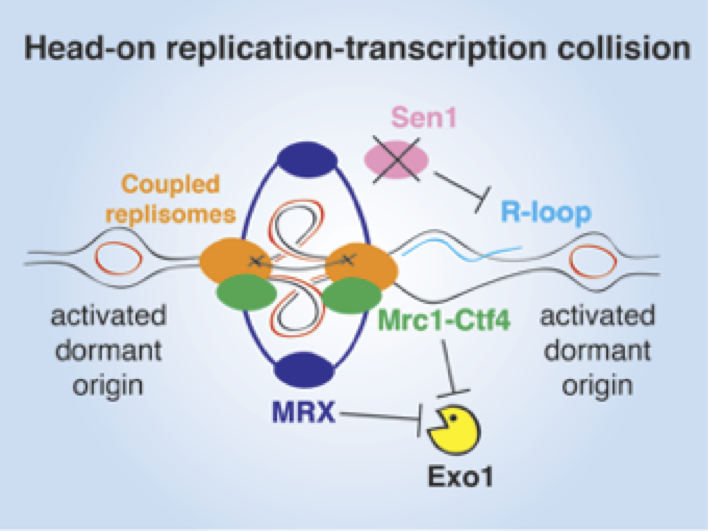Mechanisms that modulate replication fork stability and R-loop accumulation during the conflict with transcription
DNA replication and transcription are processes that can interfere with each other leading to endogenous DNA damage, which a major cause of genomic instability in cancer and other degenerative diseases. Head-on replication-transcription collisions are particularly detrimental for genome integrity maintenance, because they promote the accumulation of highly recombinogenic and mutagenic structures called R-loops (Brambati et al., 2020).
We showed that the budding yeast Sen1 helicase, the ortholog of human Senataxin mutated in cancer and AOA2/ALS4 neurological diseases, favors fork progression across transcribed genes, preventing R-loop accumulation (Alzu et al., 2012). In the absence of Sen1, transcription becomes and impenetrable barrier to fork advancing head-on, requiring specific rescue mechanisms that prevent fork breakage and terminate DNA replication (Brambati et al., 2018).

In the absence of DNA/RNA helicase Sen1 that removes R-loops, a head-on replication-transcription collision prevents bi-directional replication, reflecting a coupling between sister replisomes. Local dormant origin firing rescues the stalled forks, which are protected from Exo1-dependent resection by MRX and Mrc1-Ctf4 complexes (Brambati et al, 2018 NAR).
Our approach is to use genetic and genomic techniques combined with molecular biology methods, including the analysis of the replication intermediates by 2D gel technique (Zardoni et al., 2020), to explore the mechanisms and factors that preserve the integrity of fork colliding with transcription and the pathological transitions occurring at forks arrested by transcription in the absence of Sen1 and other anti-R-loop proteins.
References
- Brambati A, Zardoni L, Nardini E, Pellicioli A, and Liberi G (2020). The dark side of RNA:DNA hybrids. Mutat Res 784:108300.
- Alzu A, Bermejo R, Begnis M, Lucca C, Piccini D, Carotenuto W, Saponaro M, Brambati A, Cocito A, Foiani M, and Liberi G. (2012). Senataxin associates with replication forks to protect fork integrity across RNA polymerase II-transcribed genes. Cell 151: 835-846
- Brambati A, Zardoni L, Achar YJ, Piccini D, Galanti L, Colosio A, Foiani M, and Liberi G (2018). Dormant origins and fork protection mechanisms rescue sister fork arrested by transcription. Nucleic Acids Res. 46:1227-1239
- Zardoni L, Nardini E, and Liberi G (2020). 2D gel electrophoresis to detect DNA replication and recombination intermediates in budding yeast. Methods Mol Biol. 2119: 43-59.
